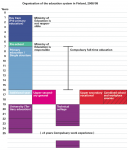Education Studio (2010)
-
10 ideas (in no particular order)
-
The Challenge
Who's really failing? Can dropouts be considered lead users for education in a diverse world?
-
The studio suggested a series of seven priority shifts addressing key elements within the education ecology. The goal is to replace “I’m doing well in school” with “I love school and I’m doing great.” Towards this goal, a set of three “hunches” were identified as important areas of action.
-
1. From equal access to education to equal opportunity to develop ones’ talents and aspirations
-
2. From the inherited Social Contract to a Social contract that includes voices of all stakeholders to create shared meaning
-
A 5 minute peek inside the Education Studio
-
3. From the current, institutional social welfare system to Social welfare system v 2.0 integrated with personal agency and empowerment
-
4. From administrative structures that are hierarchical and vertical to ones that are inclusive, open and flexible
-
5. From schools as institutions for acquisition for academic skills to schools as agents of change that inspire and produce civic innovation, creativity, and holistic growth
-
6. From a strong focus on the normative to the inclusion of all members of society with different abilities and strengths
-
7. From learning for academic achievement to learning expertise for life
-
8. Open public discourse
More voices need to be included in the public discourse, and with them a broader set of priorities. In particular, the needs and desires of children are missing, as is a shared understanding of the value of arts and athletics within school.
-
9. Strengthen international networks and collaboration
Within education, Finland has an opportunity to use its PISA status to lead internationally by developing symposia, conferences, and joint research that are multi-lateral, exporting knowledge as well as bringing in new influences and expertise. Exposure to other cultures and lifestyles builds awareness of other ways of living and strengthens the personal and cultural core; enabling students and teacher to appreciate, promote and preserve their own culture.
-
10. The New Suomi School for the 21st Century
The studio further sketched out the prototype of a new learning environment that could become the model for new schools in Finland. The emphasis was on experiential learning, collaboration, cultural skills, and problem solving so that children grow into agile thinkers who can deftly handle new situations. This involves rethinking pedagogy, roles, and infrastructure but also a proper framework for the pilot so that it has a clear pathway to broader adoption if successful.
-
Population At A Glance
Finland's population of 5.3 million is getting older, becoming more diverse with foreign nationals, and achieving increasingly high levels of education.
-
Opportunity Space
to frame the transformation identify the key dynamics within education toward developing an improved system for today and the future
-

Total number of students and dropouts. SOURCE
-

Education system of Finland SOURCE
-

Cigarette, alcohol, drug use of teenagers SOURCE
-
Health
Similar to other developed nations, the Finnish population is becoming a more sedentary and physically less active one with notable health consequences.
-
"Discontinuation increased [everywhere] except for vocational education."
-
"A standout kindergarten teacher is worth about $320,000 a year."
-

Vappu (Labour Day) is an example of Finnish drinking culture. From Candida.Performa on Flickr.
-

Dropout % in EU countries
Source: EuroStat. Data for Estonian females not available.
-

Information tehnology equipment in households
Source: Statistics Finland
-
A 7 minute segment from The BBC giving a brief introduction to school life in Finland.
-
Families
The family is still the dominant social unit in Finland; however, contemporary family life has changed from the traditional nuclear family model.
-
Discontinuation of Education
2008 report from Statistics Finland. 5 pages. 200kb.
-
-
For more...
...About this studio and how to create your own similar workshop, please see the relevant chapters in our book In Studio!
